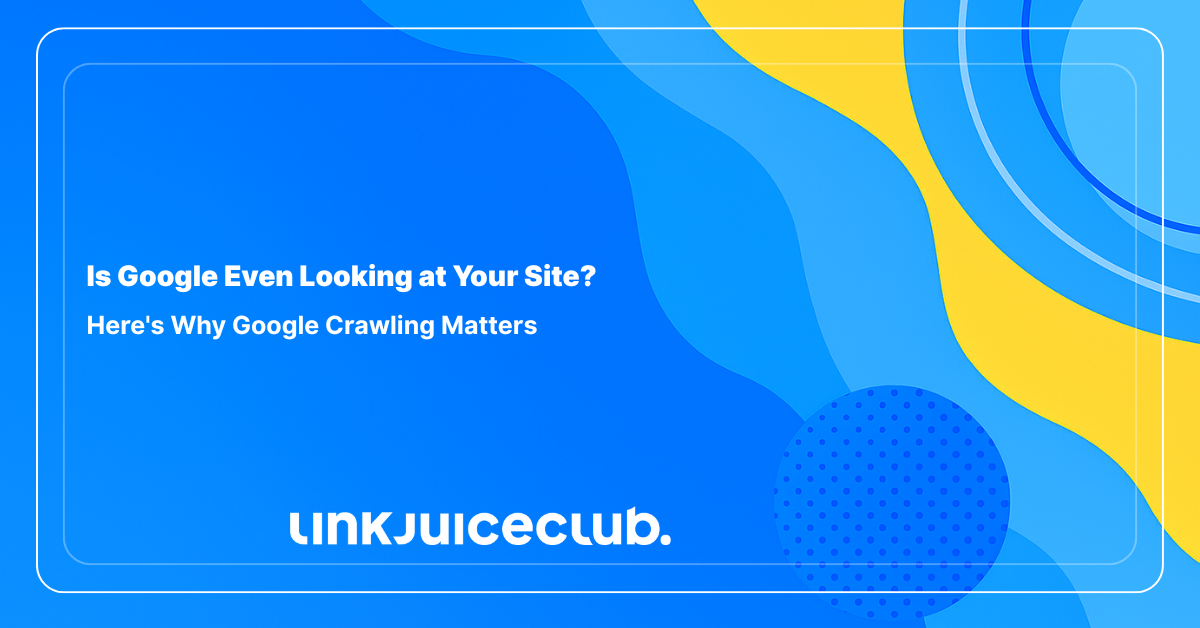
Is Google Even Looking at Your Site? Here’s Why Google Crawling Matters
You’ve built your website, filled it with valuable content, and waited for the magic to happen. But if you’re not showing up in search results as fast as you’d like, it might be time to ask: How often is Google crawling your website?
Google crawling is the behind-the-scenes process that determines whether your pages get seen, indexed, and ranked — or left gathering digital dust. If Google’s not crawling your site often enough, you’re missing out on serious traffic.
Let’s break down how Google crawling works, how frequently it happens, and what you can do to get crawled more often — and faster.

What Is Google Crawling, Really? 🕷️ It’s the Web’s Wild Librarian at Work
Imagine the internet as a never-ending library, growing every second. Google? It’s the world’s most obsessive librarian — and Google crawling is how it keeps track of every new page, update, and whisper of content.
Instead of glasses and a clipboard, Google uses its own swarm of digital bots — often called Googlebot, spiders, or crawlers.
What Google Crawling actually does:
- Follows links across your site and the web 🌐
- Reads the content, images, and structure of each page 📄
- Sends that data back to Google to decide what belongs in its index
Once your page is crawled, it might be added to Google’s search index — a digital vault that powers search results around the globe.
Just How Big Is Google’s Index in 2025?
| Metric | Data |
| Total Documents Indexed | ~400 Billion |
| Storage Space | 100+ Petabytes (100 million GB) |
| Daily Searches | 13.6 Billion+ |
| Annual Searches | ~5 Trillion |
If your page isn’t being crawled, it’s invisible. Period. Google can’t rank what it doesn’t see — and crawling is the first gate your site has to pass through.
Why Google Crawling Can Make or Break Your Online Visibility
Here’s the cold truth: if Google crawling skips your site, it’s like your business doesn’t exist online. No crawl, no index. No index, no visibility. And no visibility? That’s traffic — and customers — you’re never meeting.
If you want to show up when people search for what you sell, Google needs to see your content. That starts with crawling.
What Happens When Google Crawls Your Site?
- Your latest pages and updates get added to Google’s memory bank
- Your site becomes eligible to rank in search results
- Your brand earns credibility and digital authority over time
Why It’s Non-Negotiable:
- Ranking Power: No crawling = no indexing = zero chance to rank
- Freshness Factor: Regular crawls tell Google you’re active, not abandoned
- Relevance & Trust: High-quality content that gets crawled consistently boosts your standing with Google’s algorithm
And here’s a savvy sidenote — you don’t want every page on your site crawled. Some pages, like admin areas or post-purchase “thank you” screens, should be hidden from bots. That’s where your robots.txt file comes in handy — a topic we’ll unpack another time.
How Often Does Google Crawl Your Site? 🗓️ It Depends on What You Feed the Bot
So, how often is Google crawling your website? There’s no universal schedule. It’s not a once-a-day kind of thing — it’s a smart, resource-based decision by Googlebot.
Some sites get crawled like VIPs at an airport lounge — multiple times a day. Others? Not so much.
What Affects Crawl Frequency?
Here’s what decides how often Google pays your site a visit:
- How Fresh Is Your Content?
Sites that publish frequently — new blog posts, product updates, fresh content — send strong signals. Googlebot notices and often comes back for more. - How Powerful Is Your Site?
If your site has authority (think: solid backlinks, a good reputation, consistent traffic), it earns Google’s trust — and more crawl time. - Is Your Tech in Check?
Pages with errors, slow load speeds, or bad redirects turn Googlebot away. Broken sites get bumped down the priority list. - What’s Your Crawl Budget?
Google allocates a specific number of crawl requests per site. High-performing sites with fewer issues and lots of valuable pages get a larger slice of the crawl pie.
No Exact Formula, But Here’s the Playbook:
- Active + fast + trustworthy = frequent crawling
- Stale + broken + slow = less love from Googlebot
Keep your site humming, content flowing, and errors low — and Google will come knocking more often.
How to Get Google Crawling Your Website More Often
You can’t order Googlebot around — but you can roll out the red carpet. The goal? Make your site so irresistible that crawling becomes a habit.
Here’s your battle-tested blueprint:
1. 💻 Run a Tech Health Check
- Use Google Search Console to spot crawl errors like 404s and server issues.
- Prioritize mobile usability — if your site fumbles on phones, Google pulls back.
- Fast, error-free sites get crawled more. Period.
2. 🔍 Audit Your Robots.txt
- Located at yourdomain.com/robots.txt
- Make sure you’re not accidentally blocking Google from key pages.
- Quick win: Don’t “disallow” important content by mistake.
3. 🔗 Earn Better Backlinks
- Quality beats quantity every time.
- Get featured on niche blogs, directories, or partner sites.
- Each link is like a GPS ping telling Google to check out your content.
4. 📝 Feed It Fresh Content
- Publish regularly — blogs, case studies, service updates, anything relevant.
- Show off your E-E-A-T: share experiences, build authority, and demonstrate trust.
- Keep your content mix fresh: use images, video, and infographics to stay engaging.
5. 🗺️ Submit an XML Sitemap
- Acts like a treasure map for Googlebot.
- Submit it through Google Search Console to help Google navigate your site structure.
- Doesn’t guarantee crawling, but it’s a strong nudge.
6. 🔄 Master Internal Linking
- Link related pages naturally (blog → service page, FAQ → contact).
- Helps crawlers move around your site efficiently.
- Bonus: reinforces topic clusters and keeps users engaged.
7. ⚙️ Polish On-Page Elements
- Clear, keyword-rich title tags
- Compelling meta descriptions
- Clean URLs and fast load times (Core Web Vitals = gold)
- These make your site easier to crawl and more clickable in search.
8. 📣 Share Your Content Loud and Wide
- Post new content to social platforms and email newsletters.
- Industry outreach = more eyeballs + more backlinks
- The more traffic and shares, the faster Google finds and crawls.
How to Check If Google Has Indexed Your Pages 🔍
You hit publish, shared it around — now what? Before celebrating, let’s confirm: Is Google actually indexing your pages? Because if it’s not in the index, it’s not in the game.
Here are two quick, reliable ways to find out:
Method 1: Use the “site:” Search Command
Fastest way to check — no tools required.
Here’s how:
- Go to Google Search
- Type: site:yourdomain.com
(Example: site:example.com) - The results? Every page Google has indexed from your site
Want to check a specific page?
- Search: site:yourdomain.com/your-page-url
- If it shows up — it’s indexed.
- If you get “did not match any documents” — it’s likely not indexed yet (or there’s a crawl delay).
✅ Great for spot-checking new or updated content
Method 2: Dive Into Google Search Console
If you want a deeper look, this is your control center.
Steps:
- Log into Google Search Console (GSC)
- Select your website property
- Head to: Indexing > Pages
You’ll now see two key sections:
| Section | What It Means |
| ✅ Indexed | Pages successfully indexed and searchable |
| 🚫 Not Indexed | Pages found but not added to the index |
Common “Not Indexed” reasons include:
- Discovered – currently not indexed
- Crawled – currently not indexed
- Excluded by noindex tag
- Page with redirect
- Not found (404)
📌 Understanding these messages is your roadmap to fixing issues and getting more pages seen.
Why Google Isn’t Indexing Your Pages 😬 (And How to Fix It)
Sometimes, even when you’re doing “everything right,” Google still gives your pages the silent treatment. No index, no rankings. What gives?

Let’s uncover the most common reasons Google crawling isn’t turning into indexing — and how to flip the script:
Your Site Isn’t Mobile-First Ready
Google switched to mobile-first indexing — meaning it looks at your mobile site first, not desktop.
If your mobile version:
- Hides key content
- Breaks navigation
- Loads slower than a dial-up modem…
…then Googlebot might struggle to read or prioritize your pages.
✅ Fix it:
- Use Google’s Mobile-Friendly Test
- Compare your desktop and mobile versions side-by-side
- Keep layout, content, and links consistent across both
Not All Domain Versions Are Verified in Search Console
You might have more versions of your site than you think:
- http://example.com
- https://example.com
- http://www.example.com
- https://www.example.com
- Plus subdomains like blog.example.com
To Google, those are different sites.
If you haven’t verified them all in Google Search Console, you could be missing out on key indexing coverage.
✅ Fix it:
- Set up a Domain Property in GSC — it covers all versions and subdomains
- Still using URL-prefix properties? Add and verify every major version individually
Your Content Is Too Thin (or Just Not Useful)
Google doesn’t index everything it crawls. If a page offers little value — think:
- Duplicate content
- Low word count
- Fluff without substance
…Google might skip it entirely.
Their focus? E-E-A-T content:
- Experience
- Expertise
- Authoritativeness
- Trustworthiness
✅ Fix it:
- Create content that actually answers real questions
- Add depth: stats, visuals, expert insights
- Update old posts — don’t let them fade into irrelevance
Making Google Crawling Work For You — Not Against You
Once you understand how Google crawling actually works, the entire SEO picture starts to click. It’s not magic. It’s mechanics — and strategy.
By creating a site that’s:
- Technically solid 🛠️
- Packed with fresh, useful content 🧠
- Easy for bots to navigate 🔗
…you give Google a reason to come back — and stay interested. Frequent crawls lead to faster indexing, better rankings, and more visibility when people search for what you offer.
That means more clicks. More traffic. More customers.
SEO Isn’t One-and-Done — It’s a System That Builds Momentum
If you’re a business owner juggling ten things at once, diving deep into crawl budgets, XML sitemaps, or robots.txt probably isn’t high on your list.
But guess what? You don’t have to become an SEO wizard overnight to see results.
Whether you’re launching your first site or trying to get your blog to finally show up in search, we’re here to:
- Help Google crawl and index your site correctly
- Uncover what’s holding your pages back
- Optimize your visibility with proven, scalable SEO systems
💡 The goal? Turn your website into a lead machine — even while you sleep.
Key Takeaways: Get Google Crawling On Your Terms
Here’s what we uncovered about getting Google to crawl your site — and why it matters more than most people realize:
- Google crawling is the first step to visibility — if Google doesn’t crawl your pages, they won’t be indexed, and they won’t rank.
- You can’t force crawls, but you can influence them — by creating quality content, fixing technical issues, and using tools like sitemaps and internal links.
- Site structure, speed, mobile design, and backlinks all matter — they shape how often Google visits and how effectively it understands your content.
- Google Search Console is your home base — use it to track, troubleshoot, and optimize your crawl and index performance.
- Low-value or broken pages slow you down — eliminate thin content, fix crawl errors, and align mobile and desktop experiences.
The bottom line? Treat Googlebot like your most important visitor. Make it easy to explore your site, give it a reason to come back, and over time, it will reward you with better search presence and more eyes on your business.





